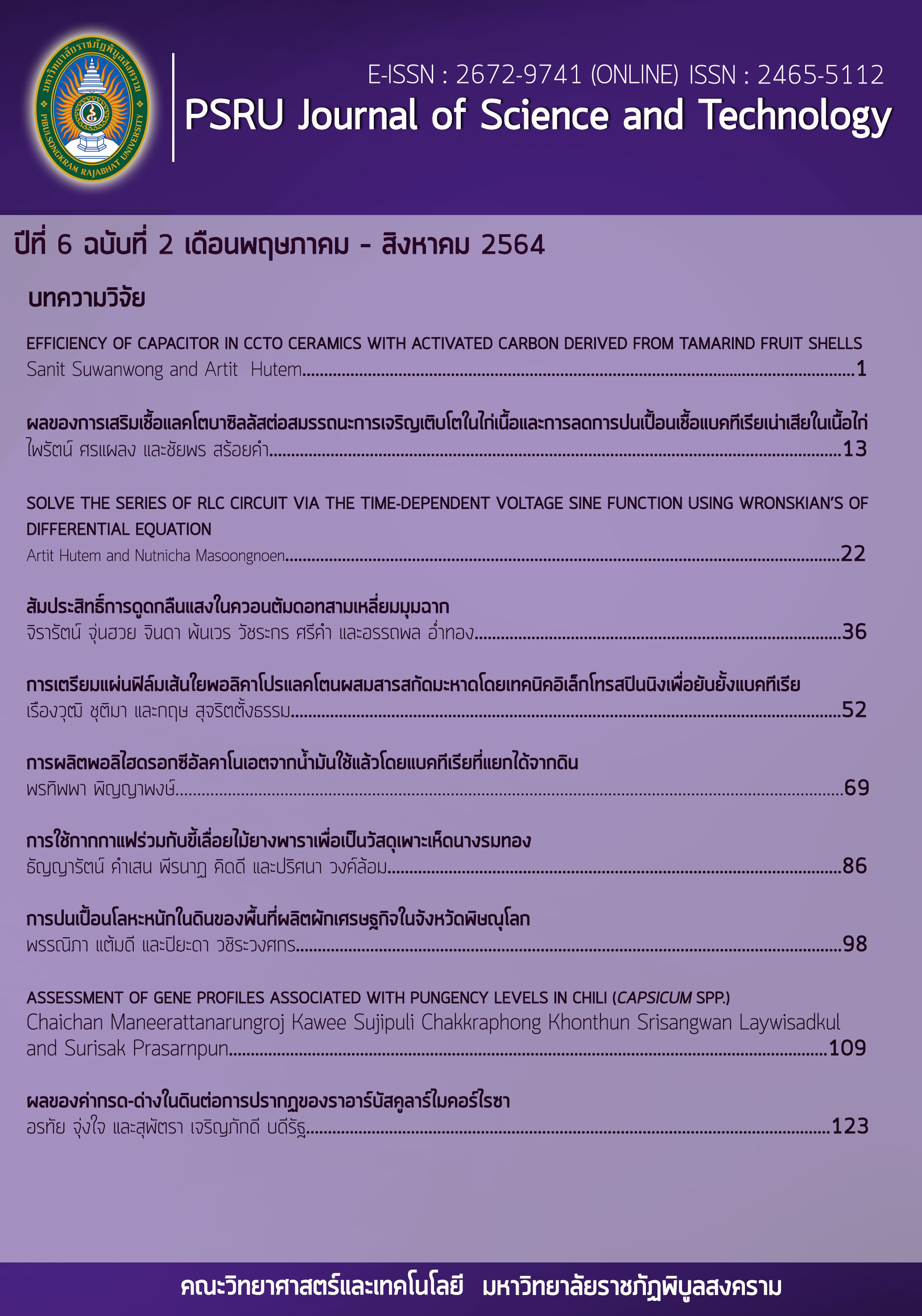EFFICIENCY OF CAPACITOR IN CCTO CERAMICS WITH ACTIVATED CARBON DERIVED FROM TAMARIND FRUIT SHELLS
Keywords:
Capacitor, Dielectric, CCTO, Activated carbon, Tamarind fruit shellsAbstract
Sweet tamarind is one of the important economic corps which tamarind fruit shells go to waste after being removed. In this study, tamarind fruit shells activated using KOH and rinsed with HCl under ambient pressure were used to synthesize activated carbon with high carbon porosity. After that, CaCu3Ti4O12 (CCTO) with high dielectric constant was synthesized using simplified method and added activated carbon in the proportion of 10, 15, 25 and 50 mol%, respectively. The results from XRD analysis of carbon phases and SEM analysis of particle profile and porosity showed that at 50 mol% phase of carbon increases and high porosity was found. Additionally, the activated carbon derived from tamarind fruit shells with 50 mol% was studied for its efficiency of capacitance, dielectric constant and dielectric loss using Impedance analyzer. It was found that CCTO with activated carbon derived from tamarind fruit shells at 50 mol% had the highest electrical capacitance and dielectric constant at 50 Hz accounting for 63-time higher than that of CCTO without activated carbon derived from tamarind fruit shells. The results also suggested that the capacitance, dielectric constant and dielectric loss decreased when the frequency was higher. This means that activated carbon derived from tamarind fruit shells increases the capacitance of CCTO ceramics and makes it suitable for the invention of electrical capacitors.
References
Bhalla, A.S., Guo, R., & Roy, R. (2000). The Perovskite Structure – a Review of its Role in Ceramic Science and Technology. Material Research Innovations, 4(1), 3-26.
Jaiban, P., Suwanwong, S., Namsar, O., & Watcharapasorn, A. (2015). Simultaneous Tuning of the Dielectric Property and Photo- induced Conductivity in Ferroelectric Ba0.7Ca0.3TiO3 via La doping. Materials Letters, 147, 29 – 33.
Lui, P., Lai, Y., Zeng, Y., Wu, S., Huang, Z., & Han, J. (2015). Influence of Sintering Conditions on Microstructure and Electrical Properties of CaCu3Ti4O12 (CCTO) Ceramics. Journal of Alloys and Compounds, 650, 59 – 64.
Masingboon, C., Eknapakul, T., Suwanwong, S., Buaphet, P., Nakajima, H., Mo, S.-K., Thongbai, P., King, P.D.C., Maensili, S., & Meewasana, W. (2013). Anomalous Change in Dielectric Constant of CaCu3Ti4O12 under Violet-to-Ultraviolet Irradiation. Applied Physics Letters, 102, 202903.
Prasertpalichat, S., Phutthichon, S., & Sumang, R. (2017). Effect of Sintering Temperature on Crystal Structure and Electrical Properties of BNT-BKT-BZT Lead-free Ceramic. PSRU Journal of Science and Technology, 2(3), 20-32.
Senthilkumar, S.T., Selvan, R.K., Melo, J.S., & Sanjeeviraja, C. (2013). High Performance Solid-State Electric Double Layer Capacitor from Redox Mediated Gel Polymer Electrolyte and Renewable Tamarind Fruit Shell Derived Porous Carbon. ACS Applied Materials & Interfaces, 5, 10541 – 10550.
Sinclair, D.C., Adams, T.B., Morrison, F.D. & West, A.R. (2002). CaCu3Ti4O12: One-Step Internal Barrier Layer Capacitor. Applied Physics Letters, 80(12), 2153.
Sudhan, N., Subramani, K. Karnan, K., Ilayaraja, N., & Sathish, M. (2017). Biomass-Derived Activated Porous Carbon from Rice Straw for a High-Energy Symmetric Supercapacitor in Aqueous and Non-aqueous Electrolytes. Energy Fuels, 31, 977 – 985.
Suwanwong, S., Eknapakul, T., Rattanachai, Y., Masingboon, C., Rattanasuporn, S., Phatthanakun, R., Nakajima, H., King, P.D.C., Hodak, S.K., & Meewasana, W. (2015). The Dynamics of Ultraviolet-induced Oxygen Vacancy at the Surface of Insulating SrTiO3 (001). Applied Surface Science, 355, 210 – 212.
Downloads
Published
How to Cite
Issue
Section
License
กองบรรณาธิการขอสงวนสิทธิ์ในการปรับปรุงแก้ไขตัวอักษรและคำสะกดต่างๆ ที่ไม่ถูกต้อง และต้นฉบับที่ได้รับการตีพิมพ์ในวารสาร PSRU Journal of Science and Technology ถือเป็นกรรมสิทธิ์ของคณะวิทยาศาสตร์และเทคโนโลยี มหาวิทยาลัยราชภัฏพิบูลสงคราม และ
ผลการพิจารณาคัดเลือกบทความตีพิมพ์ในวารสารให้ถือมติของกองบรรณาธิการเป็นที่สิ้นสุด







